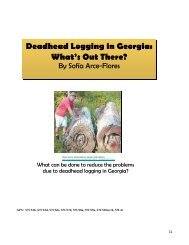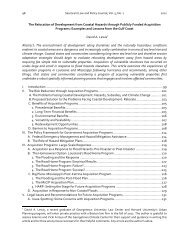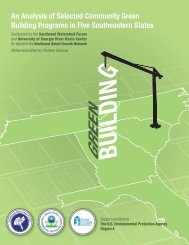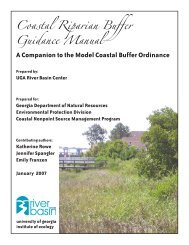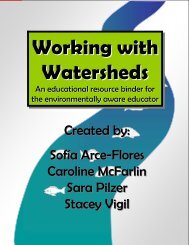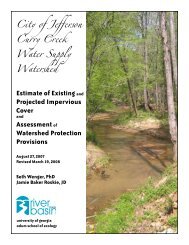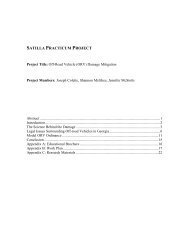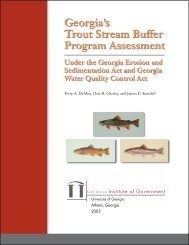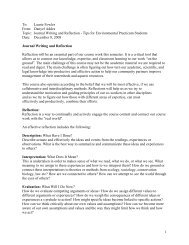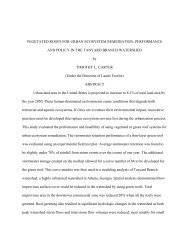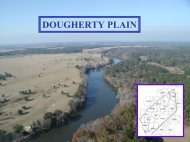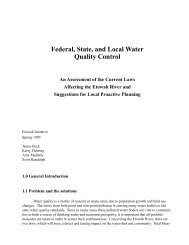1 Bibliographic Review of Sources Relevant to Development of Draft ...
1 Bibliographic Review of Sources Relevant to Development of Draft ...
1 Bibliographic Review of Sources Relevant to Development of Draft ...
Create successful ePaper yourself
Turn your PDF publications into a flip-book with our unique Google optimized e-Paper software.
Savannah River Annotated Bibliography: January 2003<br />
Naturalist 115(2): 328-335.<br />
Huenneke, L. and R. Sharitz (1990). "Substrate heterogeneity and regeneration <strong>of</strong> a<br />
swamp tree, Nyssa aquatica." American Journal <strong>of</strong> Botany 77: 413-419.<br />
These studies, conducted in the Savannah River floodplain on the SRS, demonstrate the<br />
importance <strong>of</strong> substrate heterogeneity in providing safe sites for seed germination and seedling<br />
establishment and growth. In cypress-tupelo forests, such microsites are especially important <strong>to</strong><br />
recruitment when water levels are managed in such a way that the forest floor remains inundated<br />
for prolonged times during the growing season, as was the case in the sites <strong>of</strong> the Huenneke study.<br />
Microsite heterogeneity (pit and mound <strong>to</strong>pography caused by windthrown trees) also provides an<br />
array <strong>of</strong> soil moisture and temperature conditions that may enhance establishment <strong>of</strong> bot<strong>to</strong>mland<br />
hardwood species such as oaks.<br />
Importance <strong>of</strong> winter flood events in seed dispersal<br />
Liu, E., E. Iglich, R. Sharitz and M. Smith (1990). "Population genetic structure <strong>of</strong><br />
baldcypress (Taxodium distichum) in a thermally affected swamp forest." Silvae<br />
Genetica 39: 129-133.<br />
Schneider, R. and R. Sharitz (1988). "Hydrochory and regeneration in a bald cypresswater<br />
tupelo swamp forest." Ecology 69(4): 1055-1063.<br />
These two studies, conducted on the Savannah River floodplain on the SRS, demonstrate the<br />
importance <strong>of</strong> floods as a vec<strong>to</strong>r <strong>of</strong> dispersal in cypress-tupelo forests. The Schneider and Sharitz<br />
paper measures hydrochory (water dispersal) directly by the release and recapture <strong>of</strong> marked<br />
seeds. The Liu et al. paper demonstrates the importance <strong>of</strong> dispersal in maintaining genetic<br />
variability within cypress populations but suggests that a few trees shedding seeds during periods<br />
<strong>of</strong> low water and suitable conditions for seedling establishment may be responsible for spatial<br />
heterogeneity in allele frequencies.<br />
Invasive species (Chinese tallow)<br />
Jones, R. and R. Sharitz (1990). "Effects <strong>of</strong> root competition and flooding on growth <strong>of</strong><br />
Chinese tallow tree seedlings." Canadian Journal <strong>of</strong> Forest Research 20: 5730578.<br />
Chinese tallow is an invasive tree species in the Savannah River floodplain.<br />
Highly flood and shade <strong>to</strong>lerant, the Chinese tallow has been successful in low<br />
wet areas <strong>of</strong> the floodplain.<br />
Conner, W., L. Inabinnette and C. Lucas (2001). "Effects <strong>of</strong> flooding on early growth and<br />
competitive ability <strong>of</strong> two wetland tree species and an exotic." Castanea 66(3):<br />
237-244.<br />
Invertebrates<br />
Thorp, J., E. McEwan, M. Flynn and F. Hauer (1985). "Invertebrate colonization <strong>of</strong><br />
submerged wood in a cypress-tupelo swamp and blackwater stream." American<br />
Midland Naturalist 113(1): 56-68.<br />
This article investigates the wetland characteristics that influence the colonization <strong>of</strong> wood snags<br />
by invertebrates. Uniform sections <strong>of</strong> tupelo logs were submerged in a swamp tributary, swamp,<br />
and swamp outflow locations. The logs were rapidly colonized and most reached a steady-state in<br />
14





